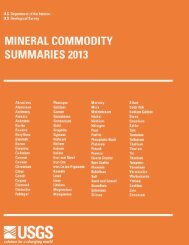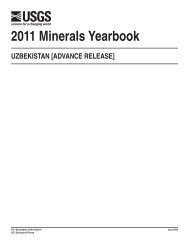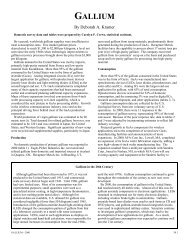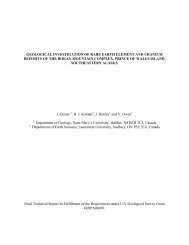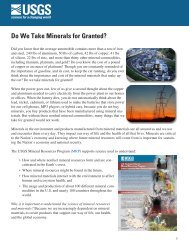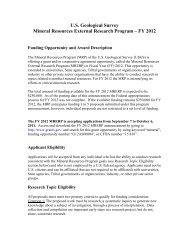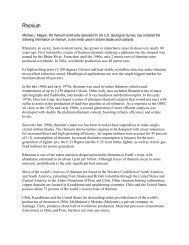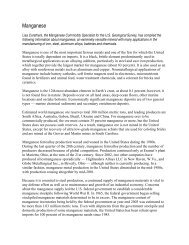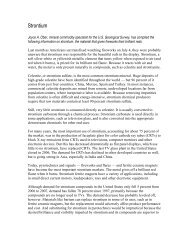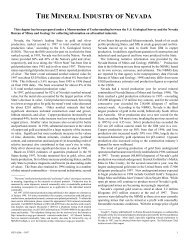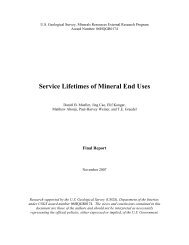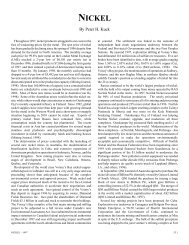Mineral Commodity Summaries 2003 - Mineral Resources Program ...
Mineral Commodity Summaries 2003 - Mineral Resources Program ...
Mineral Commodity Summaries 2003 - Mineral Resources Program ...
You also want an ePaper? Increase the reach of your titles
YUMPU automatically turns print PDFs into web optimized ePapers that Google loves.
GALLIUM<br />
Analysts continue to predict significant growth in wireless mobile handset applications, even though demand in 2002<br />
was significantly lower than originally forecast. If demand increases, the main growth driver would be existing<br />
subscribers replacing handsets to gain new features and services, such as color screens and data capability. Many of<br />
these new platforms are more complex and require additional GaAs content per phone. Despite forecasts of market<br />
growth, several companies were consolidating, reducing, or eliminating their GaAs production facilities. Research and<br />
development work continued on gallium nitride, primarily to commercialize blue and violet LEDs and laser diodes.<br />
Because of the weak market for gallium, the restart of a 50-metric-ton-per-year gallium facility in Australia that was<br />
originally scheduled for the fourth quarter of 2002 has been postponed. The U.S. firm that planned to operate the<br />
plant and expand its capacity to 100 metric tons per year has until December 2004 to begin actions to restart that plant<br />
without incurring a penalty according to the agreement with the plant’s original owners.<br />
Consumption of high-purity gallium in Japan was projected to decrease by 14% to 108 metric tons in 2002. Domestic<br />
production of 8 metric tons, imports of 55 metric tons, and scrap recycling of 45 metric tons were the components of<br />
Japanese consumption. Scrap consumption dropped sharply in 2002 to 45 metric tons from 67 metric tons in 2001.<br />
World Production, Reserves, and Reserve Base: Data on world production of primary gallium are unavailable<br />
because data on the output of the few producers are considered to be proprietary. However, in 2002, world primary<br />
production was estimated to have dropped significantly to about 61 metric tons from about 75 metric tons in 2001.<br />
China, Germany, Japan, and Russia were the largest producers; countries with smaller output were Hungary,<br />
Kazakhstan, Slovakia, and Ukraine. Refined gallium production was estimated to be about 81 metric tons; this figure<br />
includes some scrap refining. France was the largest producer of refined gallium, using as feed material crude gallium<br />
produced in Germany. Japan and the United States were the other large gallium-refining countries. Gallium was<br />
recycled from new scrap in Germany, Japan, the United Kingdom, and the United States.<br />
Gallium occurs in very small concentrations in many rocks and ores of other metals. Most gallium is produced as a<br />
byproduct of treating bauxite, and the remainder is produced from zinc-processing residues. Only part of the gallium<br />
present in bauxite and zinc ores is recoverable, and the factors controlling the recovery are proprietary. Therefore, an<br />
estimate of current reserves that is comparable to the definition of reserves of other minerals cannot be made. The<br />
world bauxite reserve base is so large that much of it will not be mined for many decades; hence, most of the gallium<br />
in the bauxite reserve base cannot be considered to be available in the short term.<br />
World <strong>Resources</strong>: 3 Assuming that the average content of gallium in bauxite is 50 parts per million (ppm), U.S.<br />
bauxite resources, which are mainly subeconomic deposits, contain approximately 15 million kilograms of gallium.<br />
About 2 million kilograms of this metal are present in the bauxite deposits in Arkansas. Some domestic zinc ores<br />
contain as much as 50 ppm gallium and, as such, could be a significant resource. World resources of gallium in<br />
bauxite are estimated to exceed 1 billion kilograms, and a considerable quantity could be present in world zinc<br />
reserves. The foregoing estimates apply to total gallium content; only a small percentage of this metal in bauxite and<br />
zinc ores is economically recoverable.<br />
Substitutes: Liquid crystals made from organic compounds are used in visual displays as substitutes for LEDs.<br />
Researchers are also working to develop organic-based LEDs that may compete with GaAs in the future. Indium<br />
phosphide components can be substituted for GaAs-based infrared laser diodes in some specific-wavelength<br />
applications, and GaAs competes with helium-neon lasers in visible laser diode applications. Silicon is the principal<br />
competitor for GaAs in solar cell applications. GaAs-based integrated circuits are used in many defense-related<br />
applications because of their unique properties, and there are no effective substitutes for GaAs in these applications.<br />
GaAs heterojunction bipolar transistors are being challenged in some applications by a new material, silicongermanium.<br />
e Estimated. NA Not available. — Zero.<br />
1 Producer published price series was discontinued. The price shown for 2002 is the estimated average value of U.S. imports for 99.9999%- and<br />
99.99999%-pure gallium.<br />
2 Defined as imports - exports + adjustments for Government and industry stock changes.<br />
3 See Appendix C for definitions.<br />
U.S. Geological Survey, <strong>Mineral</strong> <strong>Commodity</strong> <strong>Summaries</strong>, January <strong>2003</strong><br />
67



